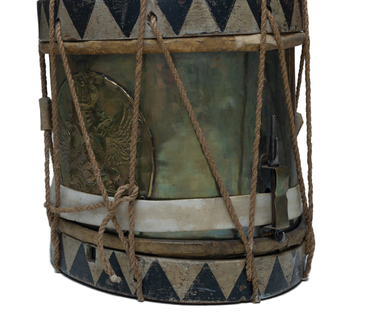The jar with the inscription “The Battle of the Alma” was created in Great Britain in 1854–1856. Presumably, it was used for household needs, such as storing jam or mustard.
The master made a jar from faience — a material that resembles porcelain but has a more porous structure and allows moisture to pass through. Therefore, faience products were covered with glaze.
All drawings on the jar are made using the underglaze painting technique. On the body, the master depicted hilly landscape, horsemen, battles, the sea with sailing ships. The inscription “The Battle of the Alma” was placed on the ribbon at the bottom.
The Battle on the Alma River is the first land battle in Crimea, which took place on September 8, 1854. The Russian army consisted of 30,000 people and 3,600 cavalrymen with 96 firearms. Its forces were outnumbered almost two to one. The Russian troops were pulled up to the village of Burliuk near the Alma River.
The battle, which began around noon, lasted for five hours. The Russian army initially had an advantage but was forced to retreat: the troops did not have a clear strategic disposition and plan of action. The enemy force had a numerical advantage and was better armed: the French, British and Turkish troops used rifles with a long firing range.
In this battle, the Russian army lost: in total five generals, 193 officers and 5,511 lower ranks were killed, wounded or shell-shocked. The losses of the enemy on the other hand amounted to about 4,500 people. But despite the defeat, the troops were able to hold back the enemy on the way to Sevastopol. The opposing forces refused to assault the city from the north side.
The manufacturing industry of the allied states fighting Russia in the Eastern (Crimean) War quickly reacted to the events in Crimea: they produced cups, plates, bottles, and jars with painted scenes of battles, portraits of heroes and military leaders, inscribed the names of the cities where major battles had taken place. In London, there was a production of plates with images of warships, figurines of Florence Nightingale — the sister of mercy and public figure of Great Britain, and other goods.
The jar from the museum collection was found in March 1971 near Oboronnoye village located on the south of the Balaklava region during earthworks. It was donated to the museum by one of the residents of the village.
The master made a jar from faience — a material that resembles porcelain but has a more porous structure and allows moisture to pass through. Therefore, faience products were covered with glaze.
All drawings on the jar are made using the underglaze painting technique. On the body, the master depicted hilly landscape, horsemen, battles, the sea with sailing ships. The inscription “The Battle of the Alma” was placed on the ribbon at the bottom.
The Battle on the Alma River is the first land battle in Crimea, which took place on September 8, 1854. The Russian army consisted of 30,000 people and 3,600 cavalrymen with 96 firearms. Its forces were outnumbered almost two to one. The Russian troops were pulled up to the village of Burliuk near the Alma River.
The battle, which began around noon, lasted for five hours. The Russian army initially had an advantage but was forced to retreat: the troops did not have a clear strategic disposition and plan of action. The enemy force had a numerical advantage and was better armed: the French, British and Turkish troops used rifles with a long firing range.
In this battle, the Russian army lost: in total five generals, 193 officers and 5,511 lower ranks were killed, wounded or shell-shocked. The losses of the enemy on the other hand amounted to about 4,500 people. But despite the defeat, the troops were able to hold back the enemy on the way to Sevastopol. The opposing forces refused to assault the city from the north side.
The manufacturing industry of the allied states fighting Russia in the Eastern (Crimean) War quickly reacted to the events in Crimea: they produced cups, plates, bottles, and jars with painted scenes of battles, portraits of heroes and military leaders, inscribed the names of the cities where major battles had taken place. In London, there was a production of plates with images of warships, figurines of Florence Nightingale — the sister of mercy and public figure of Great Britain, and other goods.
The jar from the museum collection was found in March 1971 near Oboronnoye village located on the south of the Balaklava region during earthworks. It was donated to the museum by one of the residents of the village.


